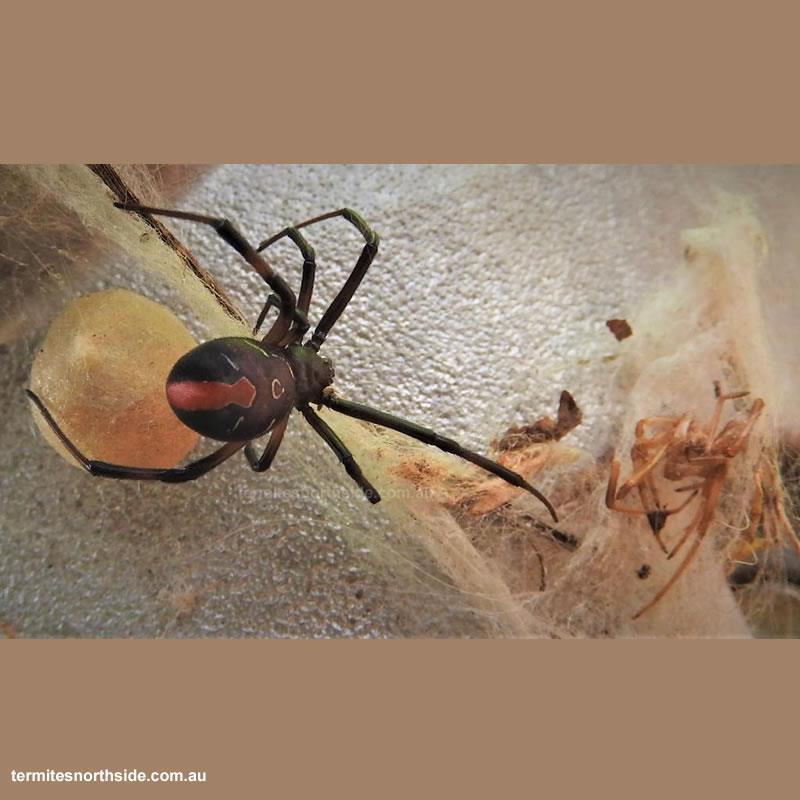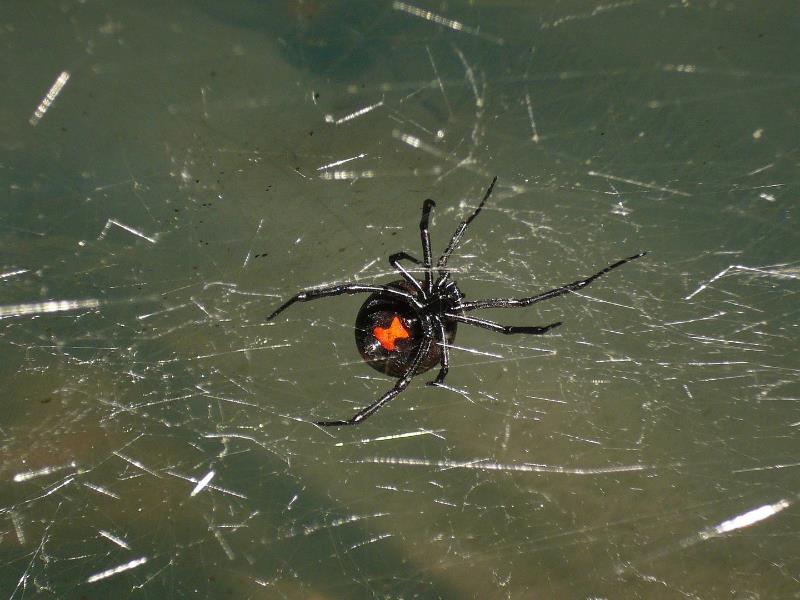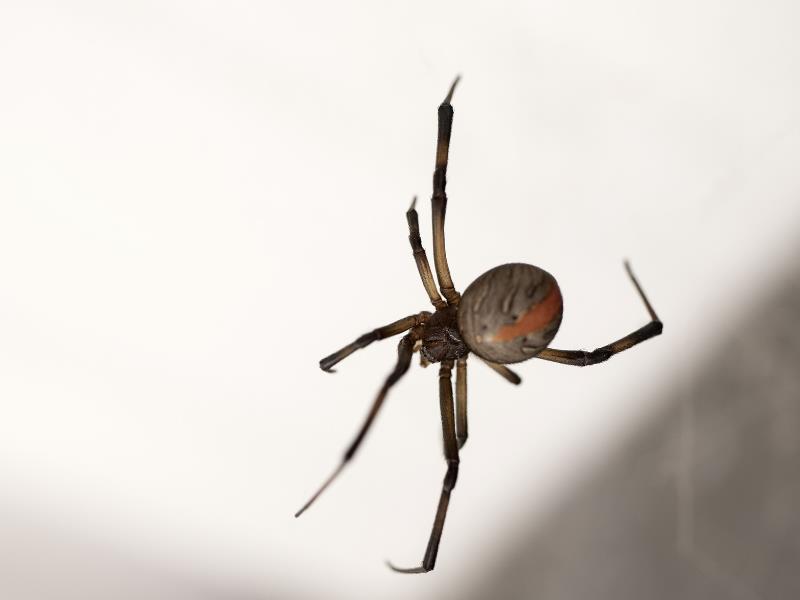Another member of the order Araneae, the Redback Spider, is a single species of spider belonging to the genus Latrodectus, commonly known as the widow spiders. As such, the Redback Spider has earned the nickname ‘Australian Black Widow’, and while the species originated here, it has since inadvertently spread to a minor selection of countries, including New Zealand, Japan, and the United Arab Emirates.
What Do They Look Like?

Redback Spider protecting eggs
The adult female Redback Spider is about 1cm in length. Its legs are slender, not hairy or fuzzy as those of a Huntsman Spider or Tarantula may be, and the first pair of legs is fairly longer than others.
The abdomen of the female spider is both large and round. While some females may present with abdomens that are either entirely black or that bear incomplete markings, most female Redback Spiders will feature a prominent red strip ribbing longitudinally along the top of the abdomen, and an hourglass-shaped scarlet marking on their underside. It is unknown exactly what purpose these markings may have, though they are consistent with markings present to deter predators within other animals. Additionally, young, juvenile female Redback Spiders will have white markings as well as the standard red or orange markings, typically taking the form of additional white bands.
In comparison to the female, the male Redback Spider is considerably smaller, typically only 3-4mm in length. Where the female spider is black, the male will be light brown, with white markings on the upper side of the abdomen, even in adulthood, and a pale hourglass mark on the underside.
After their introduction to Australia, the Steatoda Capensis has come to be regarded as the ‘false redback spider’, as they can appear physically similar. However, the S. Capensis is uniformly black or plum, and they do not bear the distinct mark of the real Redback Spiders. Exposure to their venom, though, can result in remarkably similar, albeit weaker, symptoms, and any bite inflicted by a spider that could be a Redback Spider should be treated quite seriously.
When Are They A Threat?
Redback Spiders commonly take up residence nearby human structures, including in sheds, outhouses, and inside of old, regularly-undisturbed tyres. The majority of Redback Spider bites are inflicted by the females of the species, and for some time, the smaller male spider was thought to be entirely unable to pierce the skin of a human. However, since their discovery, there have been reported cases of male bites, which means that while rare, it is possible for the smaller male to bite a human.

A black widow spider, a close relative to the Redback Spider
Typically, most bites are reported in the afternoon and evenings of the months between December and April, while the weather is warm. Considering the reluctance of the female spider to leave her web, most of these bites are the direct result of a body part coming too close to the spider. This normally happens when someone reaches into a dark cavity that, unbeknownst to them, the spider has built their web within.
How Do They Form New Nests?
Young female Redback Spiders travel via a technique called ‘ballooning’. They climb to the top of nearby objects, such as logs or rocks, before they extend their abdomens into the sky, creating a single thread of liquid silk that catches in the wind, allowing them to balloon away. The female Redback Spider will wait until that silk becomes stuck to an object, where she will build the web that she will live in for the next few years. The male, by comparison, merely follow the pheromones released by sexually active females, and they are eaten by the female shortly after mating is complete.
What Risk Do They Pose?
The venom of the Redback Spider is widely considered to be incredibly dangerous, and, if not treated correctly, can lead to death. The result of a bite from the Redback Spider is a syndrome referred to as latrodectism, and while it only creates significant pain or systemic symptoms in a small percentage of victims, that percentage is still significant. Despite that, there are no specific tests to determine whether a patient has been exposed to the venom of a Redback Spider or has developed latrodectism, and, instead, diagnosis is commonly made simply by both the condition of the patient and, ideally, identification of the biting spider.
It is uncommon for a bite to result in either local swelling or puncture
marks. Instead, within an hour of envenomation, the patient will
typically begin to develop local pain and sweating at the bite location,
and can sometimes also develop goosebumps. These symptoms can spread
along limbs, and local lymph nodes may become painful shortly
thereafter.
For every three patients, one will develop systemic symptoms such as
agitation, headache, nausea, vomiting, or abdominal or chest pain. These
symptoms can linger for weeks, potentially even months, if they are not
treated properly. Fortunately, the last death attributed to the Redback
Spider was in 2016, and even that was considered an anomaly after the
introduction of the antivenom in 1956.

A spider bearing the distinctive mark of the Redback Spider
Is There Anywhere In Particular They’re A Bigger Threat?
While there isn’t anywhere in particular that you need to be concerned about Redback Spiders, it is wise to be vigilant all around the country. You should always shake out your shoes before you put them on, especially if they have been left outside for an extended period of time, and you should avoid placing your hands, arms, feet, or legs into any dark cavity that you cannot inspect before-hand for any nesting Redback Spiders.










